MOIRCS grisms
!! Most of the information below are for the previous detectors (for data before June 2015) !!
The actual values for the current page is to be updated after the on-sky test in May 2016. Sorry for any inconvenience.
For the proposal preparation, please use the current performance. You may also consider 30-40% increase of the sensitivity in YJ band if necessary.
Available grisms and sensitivities
MOIRCS spectroscopy mode has been operating with two low-resolution grisms, a medium-resolution grism, and four high-resolution VPH grisms.
Two low-resolution "zJ500" and "HK500" grisms are characterized by its wide wavelength coverage and high throughput. The zJ500 grism is optimized for the observation of 0.9-1.78 micron regions, while the HK500 grism is optimized for 1.4-2.5 microns. Their resolution is designed to roughly R~500 under 0".5 slit width. Spectral resolution is defined by the slit width: higher resolution can be achieved for narrower slit width.
The medium resolution "R1300" grism is for a better observability of target lines between the atmospheric OH-line forest. The grism efficiency becomes worse for shorter wavelengths. Due to the intrinsically-broad line profile of the grism, the spectral resolution is roughly proportional only at the slit width larger than >0".7. This is found to be (mainly) due to the micro-cracking of the KRS5 prism used (see the website for more detail). Thus we currently do not recommend using R1300 grism for science. We have a plan to update the grism in the future.
The VPH grisms have medium to high spectral resolution and good sensitivity at their peak. Their efficiency curve is in general fairly peaky, and has a dependence on the position of the slit you cut. Peak grism efficiency also has a strong dependence on the slit position on the image. These characteristics sometimes make the mask design and the calibration data acquisition fairly complicated. Due to these special characteristics, the current mask design software does not support the VPH grisms. The use of the grisms is mainly for the experienced observers. Users who are considering the use of the VPH grisms, please visit the VPH Information Webpage. All observation with the VPH grism is still under shared-risk policy.
Estimated sensitivities listed are for a 5 sigma detection per pixel in 1 hour of on-source background-limited spectroscopy. They are calculated using the measured MOIRCS efficiency shown in Figure 5 considering the telescope efficiency and the atmospheric loss. The average sky brightness at each waveband is used for calculation, and so these values should be treated as a crude estimate. Note: they are still for the old detectors before 2016. Better sensitivity is expected for new system, especially for bluer wavelength.
| Grism name | Operating range [um] | Resolution (0.5'' slit) | Straight-through Wavelength [um] | Dispersion [A/pixel] | Sensitivity (Vega magnitude) [mag/arcsec2] (*4) |
|---|---|---|---|---|---|
| zJ500 | 0.9-1.78(*2) | 530 @ J 690 @ H |
1.12 | 5.57 | J=19.2 |
| HK500 | 1.3-2.3 (*3) | 500 @ H 690 @ K |
1.93 | 7.72 | H=17.8 K=17.6 |
| R1300 (*1) | 1.18 - 1.33 @ J 1.49 - 1.78 @ H 2.0 - 2.4 @ K |
1100 @ J 1050 @ H 920@K |
1.14 @ J 1.50 @ H 2.24 @ K |
1.91 @ J 2.61 @ H 3.88 @ K |
J=17.8 H=16.7 K=17.1 |
| VPH-Y VPH-J VPH-H VPH-K |
0.9 - 1.15 @ VPHY 1.05 - 1.4 @ VPHJ 1.4 - 1.9 @ VPHH 1.8 - 2.5 @ VPHK |
3180 @ Y 3020 @ J 2940 @ H 2680 @ K |
See the VPH webpage for more detail. |
(*1) For R1300 we use the 2nd-, 3rd-, 4th-order spectra for K, H, and J band observation, respectively. We use the imaging [broadband filters](./imag_sensitivity.html) for the order-sorting purpose. For K-band region you can use Ks-band filter instead (1.99 - 2.31 um range, with lower thermal background). The spectral resolution here is for 0.7-arcsec width slit. Note that due to the R1300 grism problem, ch2 grism resolution would not go better than this. The sensitivity is measured in 2006, not the current values. We do not recommend to use the grism due to [the problem on the grism](./r1300issue.html).
(*2) This is valid with the OC_ZJ order-sorting filter. We can observe below 9000A if we don't use the filter (to ~0.8um with lower sensitivity). However, you should be aware that the spectra will be contaminated by the second-order spectra at >1.5 um. The data without the order-sorting filter will also be affected by the additional (but small) contamination of the stray light at the blue end of the spectra.
(*3) This is valid with the OC_HK order-sorting filter. When the OC1.3 order-sorting filter is used instead, the number will be 1.3 -- 2.5 um, though with significant thermal background noise.
(*4) Background-limited performance has been assumed here, although it is sometimes difficult (for J1300 it is practically impossible).
General Comments:
-
The straight-through wavelengths will shift slightly with the position of the slit in the image.
-
Note that some spatial shift of the spectra (with respect to the slit position) is observed for the channel-1 R1300 grism spectra as well as all VPH grisms. The shift is +22 pixels to the spatial direction (+y direction on raw image, -x direction on preimage: in wmdp_moircs software it is not displayed!). For other grisms the shift is negligible.
-
The YJHKKs imaging filters are also available for the R500 spectroscopy. They may be useful for achieving more multiplicity. Be careful to the contamination of the second-order spectra during the design.
-
You can take the H-band spectral data by both zJ500 and HK500 gratings. Sensitivity is 10-40% better for HK500 grism especially for red side, though the spectral resolution is a bit better for zJ500 grating.
-
We replaced the old OC1.3 order-sorting filter to new one in October 2007, because the old filter introduced a significant second-order light longer than 2.35um. The order-sorting filter for HK500 is with thermal cut (OC_HK: 1.3--2.3um), which effectively suppress the background noise. Currently the use of OC_HK filter is the default order-sorting filter for HK*500. If your science requires the data longer than 2.3um, you should use OC1_3 order-sorting filter instead.
-
We changed the turret position of order-sorting filters (OC_zJ and OC_HK) in July 2008. The relative sensitivity between channel 1 and 2 and flat patterns should have changed slightly from the previous layout, though they should be small.
-
The dispersion direction of the VPH grisms were changed to be the same direction as the other grisms since 2016.
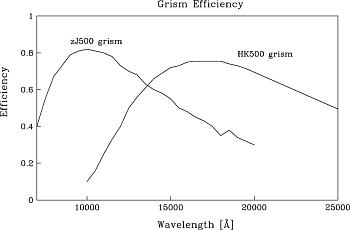
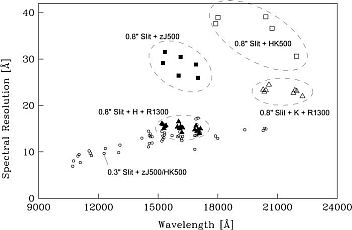
Figure 4:
(Left) The efficiencies of the zJ500 and HK500 grisms (from datasheet by the company). (Right) The actual measured values of the resolution for grisms at various wavelengths (Tokoku et al. 2007 Ph.D. thesis). OH night sky lines are used for measurement.
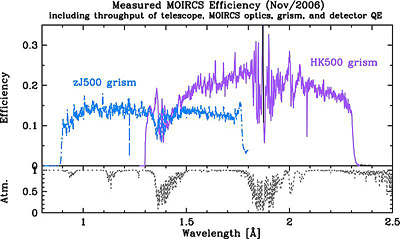
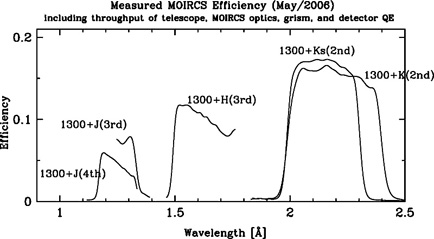
Figure 5a(left) & 5b(right):
Total MOIRCS spectroscopic efficiency for zJ500 / HK500 grisms. Channel-2 data with 2"-width slit is used for evaluation. Note that the efficiency curves around the wavelength ranges with high atmospheric absorption clearly suffer from the residual of the absorption correction. Also note that the turn-over feature seen the longest edge of the spectra of the zJ500 grism is due to the artificial pattern seen in the detector. Figure 5b(right): Total MOIRCS spectroscopic efficiency for the R1300 grism with the JHKKs filters. Channel-2 data with 2"-width slit is used for evaluation. The turn-over feature seen the longest edge of the spectra of the H+R1300 grism is due to the artificial pattern seen in the detector.
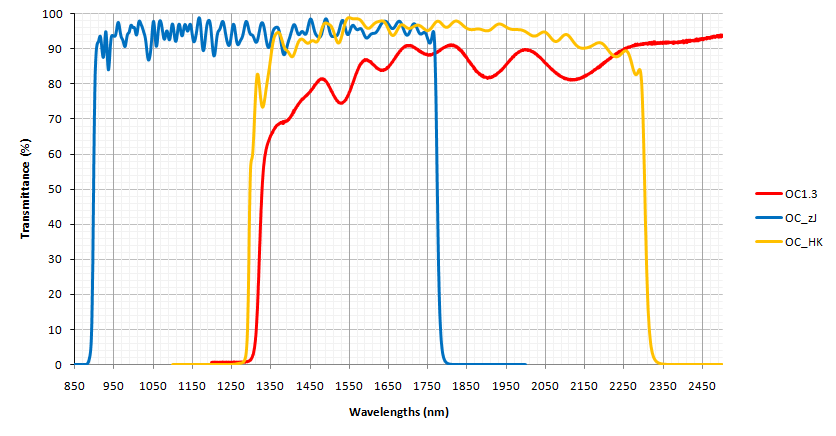
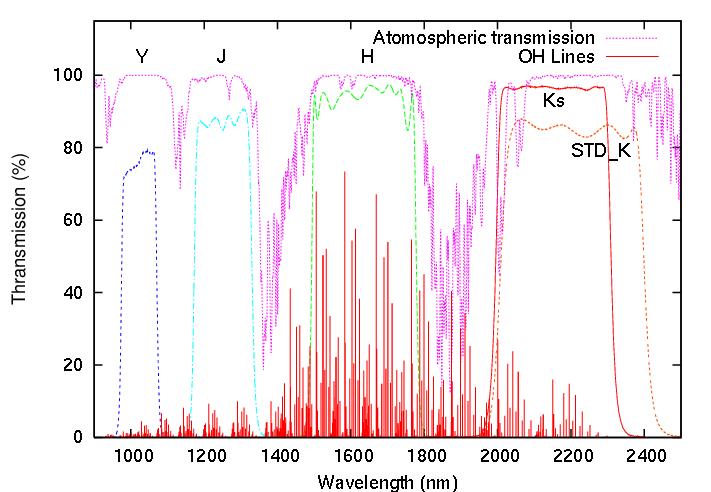
Figure 5c:
The order-sorting filters for zJ500 / HK500 / OC1_3 grisms (installed mid October 2006) as well as the YJHK filters for R1300 grism. OC1_3 filter is used for HK500 thermal cut.
User Grisms
Although we have been accepting the user grisms, the port for new grism is not available any more. Enough discussion with the observatory will be necessary if you want to make the new user grisms. The detail and the basic acceptance policy can be found in the User Filter/Grism Policy page.
Images by courtesy of Dr. Tokoku.
Please note that all data on these pages are subject to change as the evaluation of the performance of MOIRCS progresses.